INSTITUT SUPERIEUR D'ANTHROPOLOGIE
INSTITUTE OF ANTHROPOLOGY
ONLINE COURSES / COURS A DISTANCE
SPRING TERM : APRIL 2014
REGISTER NOW
INDE –  Tangasseri - It was not an archaeological excavation. But, while dredging was on for the Kollam cargo port, the seabed yielded a cache of archaeological artefacts. With this, the Tangasseri harbour complex in Kollam city has suddenly been pushed into the archaeological spotlight. A team from the Kerala Council for Historical Research (KCHR), led by its Director P.J. Cherian, inspected the site, and collected the artefacts, including some coins. Some archaeology enthusiasts claimed that the coins and other objects were 2,000 years old and from China. Nothing could be authentically established, sources said. The emergence of these artefacts from the sea could be used to establish that Kollam was a rich port city and trade centre of yore. Those were the days when ships from ancient China, Greece, Persia, and Rome regularly called at Kollam. There were claims that Kollam had a thriving Christian settlement even before the arrival of the Europeans, sources said.Jonakapuram, an area in Kollam city, could probably owe its name to the Jewish settlement of those days in Kollam, said Dr. Cherian. Following some yet-to-be-established developments, the ships suddenly stopped calling at the port, he said. Studies had also indicated that a vast portion of the bay used to be land till a couple of centuries ago, sources said. After a preliminary examination of the artefacts collected by the KCHR team, Dr. Cherian said some of the pottery fragments appeared to be of Mesopotamian origin. A couple of them were glazed both inside and outside. It suggested that they were used for some special purpose. One of the objects was a deep-blue glass piece with ‘ribbed work’ suggesting it could be of Roman origin, he said. With more studies, these objects could throw light on the history of Kollam, he said. “What has been brought out in dredging has converted the port into a historically important site,” he said.
Tangasseri - It was not an archaeological excavation. But, while dredging was on for the Kollam cargo port, the seabed yielded a cache of archaeological artefacts. With this, the Tangasseri harbour complex in Kollam city has suddenly been pushed into the archaeological spotlight. A team from the Kerala Council for Historical Research (KCHR), led by its Director P.J. Cherian, inspected the site, and collected the artefacts, including some coins. Some archaeology enthusiasts claimed that the coins and other objects were 2,000 years old and from China. Nothing could be authentically established, sources said. The emergence of these artefacts from the sea could be used to establish that Kollam was a rich port city and trade centre of yore. Those were the days when ships from ancient China, Greece, Persia, and Rome regularly called at Kollam. There were claims that Kollam had a thriving Christian settlement even before the arrival of the Europeans, sources said.Jonakapuram, an area in Kollam city, could probably owe its name to the Jewish settlement of those days in Kollam, said Dr. Cherian. Following some yet-to-be-established developments, the ships suddenly stopped calling at the port, he said. Studies had also indicated that a vast portion of the bay used to be land till a couple of centuries ago, sources said. After a preliminary examination of the artefacts collected by the KCHR team, Dr. Cherian said some of the pottery fragments appeared to be of Mesopotamian origin. A couple of them were glazed both inside and outside. It suggested that they were used for some special purpose. One of the objects was a deep-blue glass piece with ‘ribbed work’ suggesting it could be of Roman origin, he said. With more studies, these objects could throw light on the history of Kollam, he said. “What has been brought out in dredging has converted the port into a historically important site,” he said.
http://www.thehindu.com/news/national/kerala/seabed-springs-a-surprise/article5698131.ece
USA – 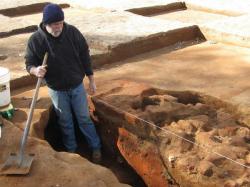 Columbia - Racing against time, South Carolina archeologists are digging to uncover the remnants of a Civil War-era prisoner-of-war camp before the site in downtown Columbia is cleared to make room for a mixed-use development. The researchers have been given four months to excavate a small portion of the 165-acre grounds of the former South Carolina State Hospital to find the remnants of what was once known as "Camp Asylum." Conditions at the camp, which held 1,500 Union Army officers during the winter of 1864-65, were so dire that soldiers dug and lived in holes in the ground, which provided shelter against the cold.
Columbia - Racing against time, South Carolina archeologists are digging to uncover the remnants of a Civil War-era prisoner-of-war camp before the site in downtown Columbia is cleared to make room for a mixed-use development. The researchers have been given four months to excavate a small portion of the 165-acre grounds of the former South Carolina State Hospital to find the remnants of what was once known as "Camp Asylum." Conditions at the camp, which held 1,500 Union Army officers during the winter of 1864-65, were so dire that soldiers dug and lived in holes in the ground, which provided shelter against the cold.
http://www.deseretnews.com/article/765647842/SC-archeologists-race-to-uncover-Civil-War-prison.html
FRANCE – 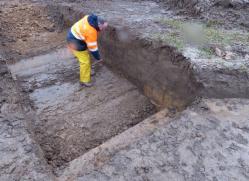 Saint-Quentin-Lamotte - Les fouilles viennent de s'achever après un mois de recherches. Des traces et des objets de plusieurs périodes ont été relevés, risquant de retarder la construction de l'usine. Le sous-sol a livré quelques-uns de ses secrets. D'abord, plusieurs périodes historiques seraient représentées : la période gauloise (du IV e siècle avant JC au IV e siècle après JC), la période gallo-romaine, enfin des traces du néolithique (5 000 avant JC).Les objets découverts sont donc nombreux et de diverses périodes également. Ces archéologues ont relevé des traces d'occupation gallo-romaine, notamment des fonds de cabane, d'ateliers semi-enterrés, de petits bâtiments. Plus rare, plusieurs dizaines de traces de poteaux pourraient correspondre à un bâtiment de grande envergure, plus de 700 m². « C'est la première fois que je trouve trois haches polies sur un même chantier », confie un chercheur, pointant la richesse du site. En coulisse, on compare cette découverte au village de Briga, qui fait l'objet de fouilles récurrentes et d'animations touristiques, en lisière de la forêt d'Eu.
Saint-Quentin-Lamotte - Les fouilles viennent de s'achever après un mois de recherches. Des traces et des objets de plusieurs périodes ont été relevés, risquant de retarder la construction de l'usine. Le sous-sol a livré quelques-uns de ses secrets. D'abord, plusieurs périodes historiques seraient représentées : la période gauloise (du IV e siècle avant JC au IV e siècle après JC), la période gallo-romaine, enfin des traces du néolithique (5 000 avant JC).Les objets découverts sont donc nombreux et de diverses périodes également. Ces archéologues ont relevé des traces d'occupation gallo-romaine, notamment des fonds de cabane, d'ateliers semi-enterrés, de petits bâtiments. Plus rare, plusieurs dizaines de traces de poteaux pourraient correspondre à un bâtiment de grande envergure, plus de 700 m². « C'est la première fois que je trouve trois haches polies sur un même chantier », confie un chercheur, pointant la richesse du site. En coulisse, on compare cette découverte au village de Briga, qui fait l'objet de fouilles récurrentes et d'animations touristiques, en lisière de la forêt d'Eu.
http://www.courrier-picard.fr/region/des-decouvertes-archeologiques-a-gros-jacques-sur-le-ia174b0n316479
INDONESIE –  Borobudur - Key tourism sites on the Indonesian island of Java were shut down on Friday as Mount Kelud’s explosive eruption blanketed a significant swath of Central Java in gray ash. Workers covered the iconic stupas and statues of Borobudur temple on Friday, closing the region’s largest tourism location to visitors. The Prambanan temple and Ratu Boko palace were also closed for the day. It was unknown on Friday when the historic sites would reopen, the sites’ tourism company told the state-run Antara News Agency. “The Borobudur temple conservation agency in Central Java has covered some of [the temple's] stupas to protect the temple stones from volcanic ash,” spokesman Indra said. “It’s predicted that the stupas will be covered for the next seven days.”
Borobudur - Key tourism sites on the Indonesian island of Java were shut down on Friday as Mount Kelud’s explosive eruption blanketed a significant swath of Central Java in gray ash. Workers covered the iconic stupas and statues of Borobudur temple on Friday, closing the region’s largest tourism location to visitors. The Prambanan temple and Ratu Boko palace were also closed for the day. It was unknown on Friday when the historic sites would reopen, the sites’ tourism company told the state-run Antara News Agency. “The Borobudur temple conservation agency in Central Java has covered some of [the temple's] stupas to protect the temple stones from volcanic ash,” spokesman Indra said. “It’s predicted that the stupas will be covered for the next seven days.”
http://www.thejakartaglobe.com/news/borobudur-other-sites-closed-after-mount-kelud-eruption/
EGYPTE – 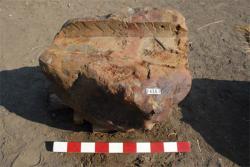 Kom el Hetan - The Egyptian minister of antiquities announces that a team of German archaeologists has discovered missing pieces belonging to the famed Colossi of Memnon. The statues, dating to roughly 1350 BC, were damaged in an earthquake during the Roman era. The colossi are some of Egypt’s oldest touristic attractions, drawing tourists since ancient times. The twin statues, over 18 meters tall each, are of Pharaoh Amenhotep III, who was worshipped as a deity. The statues are the only remains of a large temple that was built in memorial of the pharaoh. Minister of Antiquities Mohammed Ibrahim says Sunday the team made the discovery in cooperation with archaeologists from Egypt’s Ministry of Antiquities. He said the pieces belong to the belt of one statue, and the base of the other.
Kom el Hetan - The Egyptian minister of antiquities announces that a team of German archaeologists has discovered missing pieces belonging to the famed Colossi of Memnon. The statues, dating to roughly 1350 BC, were damaged in an earthquake during the Roman era. The colossi are some of Egypt’s oldest touristic attractions, drawing tourists since ancient times. The twin statues, over 18 meters tall each, are of Pharaoh Amenhotep III, who was worshipped as a deity. The statues are the only remains of a large temple that was built in memorial of the pharaoh. Minister of Antiquities Mohammed Ibrahim says Sunday the team made the discovery in cooperation with archaeologists from Egypt’s Ministry of Antiquities. He said the pieces belong to the belt of one statue, and the base of the other.
http://the-japan-news.com/news/article/0001041064?
ROYAUME UNI – 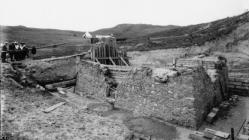 St Piran - The excavation has begun to uncover St Piran's Oratory in Cornwall.The week-long project, to be carried out by a team of volunteers led by archaeologists, is the culmination of a 15 year campaign by the St Piran Trust. Buried to protect it from the elements in 1980, the 5th century stone structure set in sand dunes above Perranporth, is claimed by some historians to be the oldest Christian building in Britain.
St Piran - The excavation has begun to uncover St Piran's Oratory in Cornwall.The week-long project, to be carried out by a team of volunteers led by archaeologists, is the culmination of a 15 year campaign by the St Piran Trust. Buried to protect it from the elements in 1980, the 5th century stone structure set in sand dunes above Perranporth, is claimed by some historians to be the oldest Christian building in Britain.
VIDEO = http://www.itv.com/news/westcountry/update/2014-02-17/st-piran-emerges-from-the-sand/?
G-B – 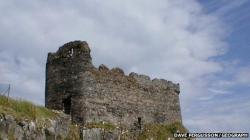
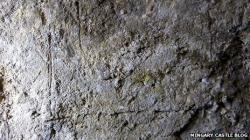 Mingary Castle: Archaeologists believe that markings scratched into the walls of a Scottish castle could be 700 years old. A team carrying out preservation work at Mingary Castle, on the Ardnamurchan peninsula, discovered the "graffiti" on plastered walls of the chapel. Some of the simple markings are thought to represent a ship and the first letter of someone's name. The archaeological team believes the markings may date from when the chapel was first built, between 1265 and 1295.Writing in his Mingary Castle blog, Mr Haylett said: "During the recent clearance work on the chapel, Tom found the graffiti in at least four areas of its walls. "It's pretty simple stuff, the sort of marks that would have been made by an illiterate man. "One 'picture' looks remarkably like Ardnamurchan lighthouse, another seems to be a ship, above, while a third suggests to me that the plasterer's name may have started with a capital 'I'."
Mingary Castle: Archaeologists believe that markings scratched into the walls of a Scottish castle could be 700 years old. A team carrying out preservation work at Mingary Castle, on the Ardnamurchan peninsula, discovered the "graffiti" on plastered walls of the chapel. Some of the simple markings are thought to represent a ship and the first letter of someone's name. The archaeological team believes the markings may date from when the chapel was first built, between 1265 and 1295.Writing in his Mingary Castle blog, Mr Haylett said: "During the recent clearance work on the chapel, Tom found the graffiti in at least four areas of its walls. "It's pretty simple stuff, the sort of marks that would have been made by an illiterate man. "One 'picture' looks remarkably like Ardnamurchan lighthouse, another seems to be a ship, above, while a third suggests to me that the plasterer's name may have started with a capital 'I'."
http://www.bbc.co.uk/news/uk-scotland-glasgow-west-26229130?
CHINE – 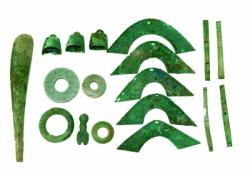 Shengle - Archaeologists unearthed ruins of a huge ancient city Shengle (30 km south ofHohhot) which dates back to the late Northen Wei Dynasty (386 - 534 AD) in InnerMongolia Autonomous Region . A large-scale funerary monument of 56 ancient tombs, which date back to the WarringStates period (475 BC- 211 BC) was found at the archaeological site along with burialobjects and another 20 tombs in different historical period.
Shengle - Archaeologists unearthed ruins of a huge ancient city Shengle (30 km south ofHohhot) which dates back to the late Northen Wei Dynasty (386 - 534 AD) in InnerMongolia Autonomous Region . A large-scale funerary monument of 56 ancient tombs, which date back to the WarringStates period (475 BC- 211 BC) was found at the archaeological site along with burialobjects and another 20 tombs in different historical period.
The rectangular remains of the ancient funerary monuments were discovered during theconstruction of a local economic zone by accident, according to Wang Dafang, an official withInner Mongolia Cultural Heritage Office. Those burial objects were mainly made of pottery,bronze, iron and jade. And the ancient tombs could be traced back to three historical timeperiods.
This discovery offers more information for the research on history and cultural division ofthe ancient city and help people better understand the history of the ancient dynasties.
http://english.peopledaily.com.cn/98649/8538019.html?